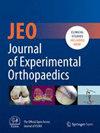No differences in knee anthropometric-related risk factors between unilateral and bilateral ACL reconstruction: A matched MRI-based cohort study
Abstract
Purpose
The primary aims of this retrospective study were to (1) compare medial posterior tibial slope (mPTS), lateral posterior tibial slope (lPTS), notch index and lateral femoral condyle ratio (LFCR) between patients who have undergone unilateral versus bilateral anterior cruciate ligament reconstruction (ACLR), measured on magnetic resonance imaging (MRI) using a matched cohort analysis; (2) evaluate whether subgroup differences exist based on age, gender and side; (3) assess risks factors for ACL injury using logistic models.
Methods
This retrospective study included patients who underwent primary ACLR between 2015 and 2019. Measurements of the unilaterally operated knee (n = 45) were matched using propensity score-matched in a ratio of 1:1 with the corresponding knee in the bilateral group (n = 45) based on age, sex, side, using the greedy nearest neighbour method. Exclusion criteria included inadequate MRI quality (<1.5 Tesla), concomitant ligament injuries or fractures, and <6-year follow-up for unilateral ACLR patients. Five blinded reviewers measured mPTS, lPTS, femoral notch index and LFCR on MRI scans.
Results
No significant differences were observed between the bilateral and unilateral groups for mPTS, lPTS, femoral notch index or LFCR. The mean values for the bilateral group were: mPTS, 3.84° ± 2.54°; lPTS, 6.03° ± 3.63°; notch index, 0.27 ± 0.02; and LFCR, 0.73 ± 0.07. Corresponding values for the unilateral group were: mPTS, 3.92° ± 2.94°; lPTS, 6.37° ± 3.13°; notch index, 0.27 ± 0.03; and LFCR, 0.71 ± 0.06 (all p > 0.05). Subgroup analysis revealed a statistically significant difference only for the femoral notch index in patients older than 25 years: bilateral ACLR (0.29 ± 0.03) versus unilateral ACLR (0.27 ± 0.03; p = 0.027).
Conclusions
Patients who underwent bilateral ACLR showed no significant differences in mPTS, lPTS, femoral notch index or LFCR, compared with those who underwent unilateral ACLR, irrespective of age, gender and side.
Level of Evidence
Level III, cross-sectional study.




 求助内容:
求助内容: 应助结果提醒方式:
应助结果提醒方式:


